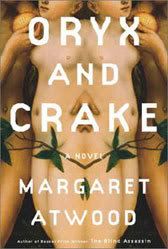When I first began reading this book, I wasn't entirely taken by the author's use of language, but the further that I read, the more infectious the language became until I found that I couldn't put the book down. Atwood takes current societal issues and extrapolates on them, presenting one possible future in a witty and satirical manner.
The first thing that the reader understands is that the climate has changed drastically, obliterating once coastal cities and warming the Earth to such a degree that living in the open air is unhealthy and uncomfortable. A small number of priviledged families have escaped this discomfort by existing in self-contained compounds while profiting from those less fortunate and less esteemed than themselves. This larger portion of the population lives in the “Pleeblands,” an uncontrolled area riddled with crime and poverty.
Another major theme of the book is the negative effect that bioengineering could potentially have on the ecosystem and society if driven only by profit and without ethical consideration. There are several instances where the reader views scientists inflicting greater harm on the system in an attempt to right previous blunders or to “improve” the lives of human beings. Atwood's dialogue can be heavy-handed at times, but I didn't find it at all off-putting. In fact, I found that she often did well in pointing out how convenience and a situation where demand is greater than supply can lead to some rather absurd ideas on how to “fix” things.
One complaint that I initially had regarding this book is the lack of discussion of some of the characters' motivations, but the more that I think about it, the more that I feel that it's not important to Atwood's message. I'm not going to go into detail, which would result in spoilers, but I will say that I don't think it really matters if the intentions are good or bad when the result of an act destroys the entire world... I mean really, at that point, it's a little late to determine whether or not something was a good idea. Snowman certainly didn't get the chance to fully understand it, and this is his story.






0 comments:
Post a Comment